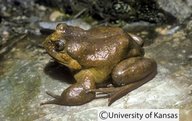|
Description
Telmatobius necopinus belongs to a clade where there are no proposed synapomorphies supporting the monophyly of Telmatobius, Telmatobiini, Telmatobinae, or Leptodactylidae, though the presumptive synapomorphies for the group are (1) frontoparietals fused posteriorly, and (2) nuptial excresence on Finger 1 only (which are not universal across all Telmatobius). T. necopinus can be differentiated from its congeners by the following combination of characters: (1) premaxillary teeth present, (2) tympanum absent, (3) nuptial spines large, conical; nuptial pad on dorsal surface of thumb and separate from inner palmar tubercle, (4) dorsal coloration (see below), (5) skin on dorsum is smooth, (6) max SVL in males up to 71.4 mm and 72.9 mm in females, (7) eye not protuberant dorsally, (8) toes not extensively webbed, (9) nasals slender and curved anteriorly at midlength, (10) zygomatic ramus of squamosal longer, (11) median process of sphenethmoid extending between nasals, (12) tympanic annulus reduced to paired remnants.
Head is narrower than or as wide as the body and wider than it is long (HW is 38.4-39.9% SVL). Maxillary and premaxillary teeth fanglike.
Relative finger lengths: III>I=IV>II. In males, the fringe on inner margin of thumb is well developed. Relative toe lengths: IV>V ³III>II>I. A transverse fold of skin is present dorsally to the opening of the cloaca in all but one specimen analyzed. In life, T. necopinus are a dull brown dorsally with yellowish-tan flecks, and olive-gray venter, and a bronze iris with black reticulations (Wiens 1993).
Distribution and Habitat
Country distribution from AmphibiaWeb's database: Peru
Known only from the easternmost ridge of the Cordillera Central at an elevation of 2050 m. The type locality is in cloud forest within the very humid Lower Montane Forest Zone. Life History, Abundance, Activity, and Special Behaviors
Three specimens were found on a muddy roadside ditch at night, the fourth specimen was under an adjacent rock near a stream (Wiens 1993). Possible reasons for amphibian decline General habitat alteration and loss
References
Wiens, J. J. (1993). ''Systematics of the leptodactylid frog genus Telmatobius in the Andes of Northern Peru.'' Occasional Papers of the Museum of Natural History of the University of Kansas, (162), 1-76.
Originally submitted by: Raul E. Diaz (first posted 2004-08-27)
Edited by: Tate Tunstall (2023-02-26)Species Account Citation: AmphibiaWeb 2023 Telmatobius necopinus <https://amphibiaweb.org/species/2710> University of California, Berkeley, CA, USA. Accessed May 17, 2025.
Feedback or comments about this page.
Citation: AmphibiaWeb. 2025. <https://amphibiaweb.org> University of California, Berkeley, CA, USA. Accessed 17 May 2025.
AmphibiaWeb's policy on data use.
|



 Map of Life
Map of Life